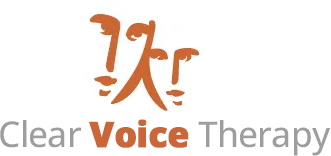Is your voice hoarse and raspy?
Do you find your pitch range isn’t what it used to be?
Does your voice cut out, or do you experience temporary breaks in the voice?
Do you clear your throat frequently, or have the feeling that there is mucous caught in your throat that just won’t go away?
Is your jaw, chest, and neck tight/painful when speaking?
Do you have difficulty adjusting the volume of your voice (loud/soft) and are you able to project your voice when needed? Does talking feel more effortful?
These are all common symptoms of voice problems that can impact how you sound and your overall communication. Learn how to take care of your voice and prevent voice problems! Disorders stemming from misuse, trauma to the vocal folds, or overuse are common and preventable voice disorders.
We provide treatment to individuals who would like to recover voice function following medical diagnoses of voice disorders such as: Muscle Tension Dysphonia (MTD), Spasmodic Dysphonia, Paradoxical Vocal Fold Dysfunction (PVFD), nodules, polyps, chronic laryngitis, and vocal cord paralysis. Training is also provided to those individuals who would like to improve voice quality for personal and/or professional use. Professional voice users include anyone who relies on his/her voice for work. Teachers, actors, singers, salespeople, and coaches are just a few examples.
The Foundation of Expression
We need a clear intent to communicate, and this is the first layer where things can get stuck, squeezed or strangled. For various reasons, what we want or need to say doesn’t always come out effectively. When we learn to match up our intent with good functional speech production, our words gain more strength and clarity.
Your breath is the foundation of expression. Physiologically, the lungs, ribs and diaphragm work together to facilitate proper breathing. The air stream vibrates the vocal folds while different muscles of the larynx tense or relax the folds in order to create different pitches. The articulators (jaw, lip, tongue, palate) serve to form the sounds we make and are also part of the vocal resonating cavity. These structures can be influenced by physical factors such as trauma, as well as by emotional factors and stress.
Regardless of whether the difficulty with your voice arises as an inner hesitancy to speak, or a physical issue when you do talk, voice therapy can help to create a voice that is strong and steady, confident and clear. Experience improved resonance, pitch range, vocal quality and trust in your voice!
Therapeutic interventions may involve one or more of the following:
- Vocal hygiene training: learning how to care for your voice as the precious instrument it is
- Specialized diaphgramatic breathing techniques to support the voice and enhance overall relaxation and well being
- Manual and Structural Therapies to reduce muscle tension and improve mobility of structures for improved voice function. Techniques include Craniosacral Therapy, Myofascial Release, muscle energy and Visceral Manipulation.
- Resonant voice techniques to improve vocal quality and voice projection while eliminating strain/tension with speaking
- Specialized stretching and strengthening exercises are utilized to improve posture, reduce tension, and build awareness for proper voice technique.
Voice and speech therapy may be covered by insurance. A physicians order is needed if we are billing insurance and is generally provided by an Ears, Nose and Throat Doctor (ENT), Pulmonologist, or Primary Care Physician.


